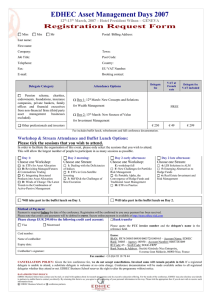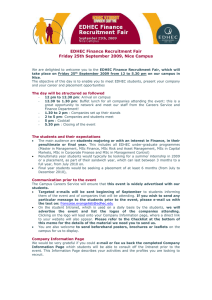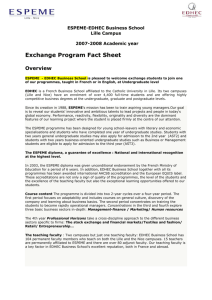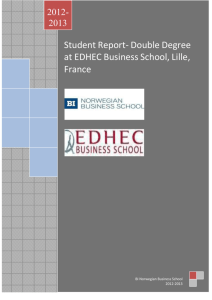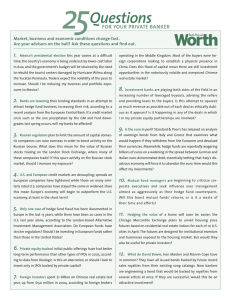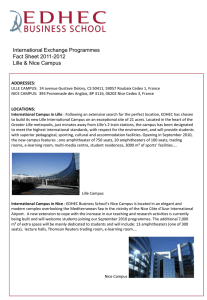Edhec European Alternative Multimanagement Practices Survey Noël Amenc
advertisement
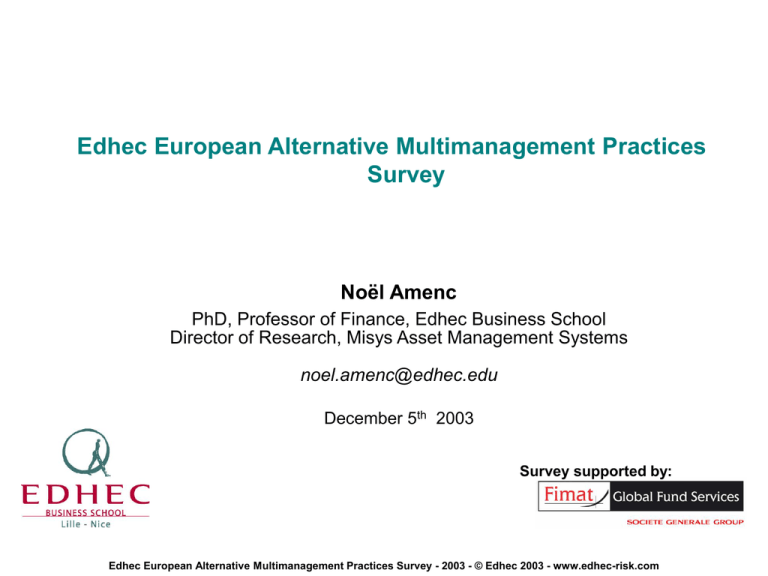
Edhec European Alternative Multimanagement Practices Survey Noël Amenc PhD, Professor of Finance, Edhec Business School Director of Research, Misys Asset Management Systems noel.amenc@edhec.edu December 5th 2003 Survey supported by: Edhec European Alternative Multimanagement Practices Survey - 2003 - © Edhec 2003 - www.edhec-risk.com Agenda Methodology Facts, figures and trends in the European alternative multimanagement market Asset allocation and portfolio construction Fund selection and due diligence Risk and performance reporting Regulatory framework Conclusions and recommendations Glossary Typology of hedge fund styles Edhec European Alternative Multimanagement Practices Survey - 2003 - © Edhec 2003 - www.edhec-risk.com Methodology Scale of the initiative A pan-European initiative Two main questionnaires: – General questionnaire for large asset managers – Specific questionnaire targeting multimanagement structures Survey conducted from 30/06/2002 to 31/12/2002 61 respondents managing €136bn at 31/07/2002 Distributionof ofrespondents respondentsby bycategory category Distribution Direct Investors 18% Distribution Alternative Multimanagers by number Distribution ofofalternative multimanagers by number Other European countries 7% France 18% United Kingdom Advisors 14% 21% Switzerland Funds of Hedge Funds 68% 34% 23% 26% 28% 0% 5% 10% 15% 20% Number of Respondents 25% 33% 30% European Universe Edhec European Alternative Multimanagement Practices Survey - 2003 - © Edhec 2003 - www.edhec-risk.com 35% 40% Methodology Analysis of the size bias 44% of the sample is individually managing more than €1bn; Bias not inconsistent with the fact that the 50 largest FoHF manage 90% of assets (Freeman & Co, 2003); Distribution of respondents Distribution of respondents by size by size AUM > €10bn 4% €5bn < AUM < €10bn 4% €1bn < AUM < €5bn 18% €250mn < AUM < €1bn 18% AUM < €250mn 17% 0% 5% 10% 15% 20% Edhec European Alternative Multimanagement Practices Survey - 2003 - © Edhec 2003 - www.edhec-risk.com Methodology Importance of the background research The survey has been designed and commented on with reference to an analysis of the academic and professional state-of-the-art for alternative multimanagement practices This state-of-the-art has been documented in the background section by the Edhec Risk and Asset Management Research Centre based on the information collected in the context of its permanent scientific and industrial observatory (more on www.edhec-risk.com). Edhec European Alternative Multimanagement Practices Survey - 2003 - © Edhec 2003 - www.edhec-risk.com Facts, figures and trends Main actors A market structure similar to the US – High Net Worth Individuals still represent the main category of investors; – But institutional investors’ allocations growing at fast pace; Fund of Hedge Funds investor composition (%) Source: Goldman Sachs Prime Brokerage Annual Hedge Fund Survey, 2003 Edhec European Alternative Multimanagement Practices Survey - 2003 - © Edhec 2003 - www.edhec-risk.com Facts, figures and trends Relativisation of alternative performance The growing importance of institutional investors – Investment approaches more related to diversification than absolute performance; – Need for normalisation of alternative investments (benchmarks, reporting); – Greater attention paid to operational risks. Edhec European Alternative Multimanagement Practices Survey - 2003 - © Edhec 2003 - www.edhec-risk.com Facts, figures and trends From an alpha to a beta logic 63% of respondents offer FoHF by strategy; Current motivations for investors, specifically institutional investors, lie in the diversification benefits rather than in the selection of the best managers, which is a preoccupation of Multimanagers; Do you offer pure strategy manager funds Do you offer pure strategy manager funds? Yes 63% No answer 4% No, but we will soon 4% No 29% Why (rank) Why do do Investors investorsinvest investininFoHF FoHF? (rank) Advantages Diversification Risk Management Capacity/Access to Funds Due Diligence Manager Selection Consolidated Reporting Investors 1 2 4 3 5 6 HFoF Source: A Guide to Funds of Hedge Funds Management and Investments AIMA, 2002 Edhec European Alternative Multimanagement Practices Survey - 2003 - © Edhec 2003 - www.edhec-risk.com 1 4 5 3 2 6 Facts, figures and trends Relativisation of alternative performance From an absolute performance to a relative returns approach – The absence of exposure to market risk does not mean that hedge funds do not carry any risk; The risk free rate is not an appropriate benchmark It is necessary to consider the risks strategies are exposed to in the performance measurement approach Relative approach to performance measurement Edhec European Alternative Multimanagement Practices Survey - 2003 - © Edhec 2003 - www.edhec-risk.com Facts, figures and trends Relativisation of alternative performance Alternative indices – The need to demonstrate relative performance leads to the significant growth of alternative indices. – These indices are not only used for hedge fund performance analysis but also as investment vehicles (trackers, structured products). What indices do you use? Country Market indices Proprietary indices Composite indices based on market indices Others France 100% 25% 25% 25% Country HFR CSFB Zurich MSCI Indexes (Standard, Value, Growth) S&P500 JPM Switzerland United Kingdom 45% 25% 9% 25% 36% 25% 27% 25% France 50% 25% 25% 0% 25% 0% Others 20% 7% 43% 11% Switzerland United Kingdom 20% 50% 40% 50% 20% 0% 0% 20% 0% Total Europe 48% 17% 32% 22% Total Europe 27% 27% 13% 50% 0% 50% Edhec European Alternative Multimanagement Practices Survey - 2003 - © Edhec 2003 - www.edhec-risk.com 20% 13% 13% Facts, figures and trends Relativisation of alternative performance The utilisation of indices is not problem-free – Indices are not passive, they are constructed like active manager funds; – Indices suffer from numerous biases, mostly related to the absence of regulation with regard to the publication of performance and hedge fund composition; – Selection and construction methods are the source of the performance rather than the strategies. Maximum returnMaximum difference by style (From January through July 2003) Return Differences by Investment Style (From January 19981998 through July 2003) Investment Styles Convertible Arbitrage Max differences (with dates and indexes) 7.55% Dec 01 EACM (-6.93%) vs. Hennessee (0.62%) CTA 5.09% Feb 99 Distressed Securities 6.99% Feb 00 EACM (1.23%) vs. Zürich (8.22%) 19.45% Aug 98 MAR (-26.65%) vs. Altvest (-7.20%) Equity Market Neutral 5.00% Dec 99 Hennessee (0.20%) vs. Van hedge (5.20%) Event Driven 5.06% Aug 98 Emerging Markets Fixed Income Arbitrage Funds of Hedge Funds 10.48% Oct 98 8.01% Dec 99 Global Macro 14.17% Oct 98 Long/Short Equity 22.04% Feb 00 Merger Arbitrage 2.71% Sept 01 Relative Value 10.47% Sept 98 Short Selling 21.13% Feb 00 CSFB (-0.54%) vs. HF Net (4.55%) CSFB (-11.77%) vs. Altvest (-6.71%) HF Net (-10.28%) vs. Van Hedge (0.20%) MAR (2.41%) vs. Altvest (10.42%) CSFB (-11.55%) vs. Altvest (2.62%) EACM (-1.56%) vs. Zürich (20.48%) EACM (-4.32%) vs. HF Net (-1.61%) EACM (-6.08%) vs. Van Hedge (4.40%) Van Hedge (-24.30%) vs. EACM (-3.17%) Source: Edhec Risk and Asset Management Research Centre Edhec European Alternative Multimanagement Practices Survey - 2003 - © Edhec 2003 - www.edhec-risk.com Facts, figures and trends Relativisation of alternative performance In order to overcome these difficulties, Edhec has constructed a series of indices of indices that exhibit higher levels of representativity and purity Representativity Representativity Purity 3,00 3,00 2,50 3,00 2,50 2,33 2,08 2,00 2,00 2,00 1,67 1,60 1,60 1,50 1,50 1,50 1,50 1,50 1,42 1,00 1,00 1,00 0,88 0,75 0,57 0,56 0,43 0,50 0,50 0,50 CSFB EACM CISDM Van Hedge HFR Altvest Zurich Hennessee Edhec S&P EACM HF Net 0,00 0,00 Hennessee CISDM Van Hedge Altvest HFR Zurich CSFB HF Net 0,00 0,00 S&P 0,63 0,63 Edhec Source: Edhec Risk and Asset Management Research Centre, 2003 Edhec European Alternative Multimanagement Practices Survey - 2003 - © Edhec 2003 - www.edhec-risk.com Facts, figures and trends Increasing attention to operational risks The increasing importance of institutional investors and their desire to protect themselves against operational risks is resulting in greater attention being paid to these types of risks, which represent the most significant source of hedge fund failures. Analysis Hedge Fund Funds Failures Analysis ofofHedge Failures Multiple Risks 6% Percentage of hedge funds potentially open to a specific % of HF potentially open to aissue specific operational issue operational Compliance 63% Pricing & NAV calculation Operational Risk only 50% Investment Risk Only 38% 58% Client reporting 39% Risk Management 27% Reconciliation Business Risk Only 6% Source: Capco research and Working 23% 0% 10% 20% 30% 40% 50% 60% 70% Source: Edhec Risk and Asset Management Research Centre, 2003 Paper “Understanding and Mitigating Operational Risk in Hedge Funds”, 2002 Edhec European Alternative Multimanagement Practices Survey - 2003 - © Edhec 2003 - www.edhec-risk.com Asset allocation and portfolio construction Specialization of offerings Specialized fund offerings are provided more as an answer to benchmarking needs rather than for their real diversification benefits; Only 42% of respondents offer funds exhibiting specific diversification attributes with other asset classes; you offer FoHF with specific behaviour or DoDoyou offer FoHF with specific behaviour or diversification diversification objectives in relation to other asset objectives in relation to other asset classes? classes? Yes 42% No answer 7% Country Yes No No, but we will soon No answer No, but we will soon 7% France 40% 40% 10% 10% Switzerland United Kingdom 47% 40% 41% 50% 0% 12% No 44% Edhec European Alternative Multimanagement Practices Survey - 2003 - © Edhec 2003 - www.edhec-risk.com 0% 10% Asset allocation and portfolio construction Specialization of offerings Multimanagers’ lack of attention to the diversification properties of hedge funds is probably linked to the confusion that exists between the fund selection tasks, which constitute the original value-added of the FoHF, and those relating to allocation or diversification by style. While a significant majority of European FoHF (75%) have a team dedicated to portfolio construction and/or return forecasts for alternative styles, one cannot help but observe that numerous European multimanagers continue to confuse portfolio allocation with the choice of the best managers (22%). Country Members of staff you have a team dedicated portfolio DoDo you have a team dedicated totoportfolio construction and/or economicstyle stylereturn return construction and/or economic forecasting? forecasting? France 4 No 25% Yes 75% Switzerland 5 United Kingdom 8 Edhec European Alternative Multimanagement Practices Survey - 2003 - © Edhec 2003 - www.edhec-risk.com Europe 5 Asset allocation and portfolio construction A necessary clarification of means and practices Only 13% of respondents combine a quantitative approach with a qualitative portfolio construction approach, even though it is the only method that allows scenarios on extreme market conditions to be taken into account while, at the same time, disciplining and formalising the manager’s intuitions; How do you construct your portfolio for multi-strategy or multi-style funds? 65% of European multimanagers do not use a quantitative approach in the area of strategic portfolio allocation, despite the results of such approaches that have been highlighted by academic research; Only 47% of the professionals questioned take the correlation between funds into account to organise the diversification of their portfolio. Edhec European Alternative Multimanagement Practices Survey - 2003 - © Edhec 2003 - www.edhec-risk.com Asset allocation and portfolio construction How much diversification is enough? Academic studies have documented the fact that increasing the number of funds may have adverse effects: – Dilution of the specific betas of the different strategies employed; – Alpha dilution and increase in additional costs (due diligence, How many funds on average make up your ownup funds? monitoring, etc.); How many funds on average make your 5% own FoHF? 13% – Increase in the kurtosis of the funds; 5% – Quantity can not replace adequate 22% due diligence; Fewer than 10 The numbers for practitioners are significantly above the optimal academic findings (Amin and Kat, Lhabitant and Learned), as only 18% of respondents hold FoHF that include fewer than 15 funds. 10 to 15 15 to 20 5% 20 to 25 33% 16% 25 to 30 More than 30 No answer Country France Switzerland United Kingdom Others Europe 0% 6% 20% 22% Fewer than 10 13% 0% 6% 0% 11% 10 to 15 5% 30% 47% 50% 11% 15 to 20 33% 20% 6% 10% 28% 20 to 25 16% 10% 0% 10% 6% 25 to 30 5% 30% 29% 10% 17% More than 30 22% 10% 6% 0% 6% No answer 5% Edhec European Alternative Multimanagement Practices Survey - 2003 - © Edhec 2003 - www.edhec-risk.com Fund selection and due diligence A match made in heaven? While most alternative strategies exhibit abnormally distributed returns, the vast majority of hedge fund selectors continue to use tools from traditional management to evaluate their performance. 82% consider the Sharpe ratio and only 4% calculate an Omega ratio, despite the fact that the latter is more appropriate for the alternative universe. Which quantitative indicators dodoyou usewhen when monitoring performance? Which Quantitative Indicators you use monitoring manager manager performance? Total Europe Sharpe Ratio Sortino Ratio M2 or SRAP Ratios Drawdown Ratio Return/VaR Information Ratio Return Semi-deviation Historique des ratios de Sharpe Tracking error ex-ante Correlation Standard deviation Beta Alpha Omega B VaR Skewness & Kurtosis BULL/BEAR Rolling 3 year annualised returns Recovery Time Very Important 35% 18% 2% 47% 24% 27% 5% 4% 4% 4% 4% 5% 4% 4% 2% 2% 2% 2% 0% 4% Important Not very important 47% 40% 13% 33% 35% 22% 0% 0% 0% 2% 4% 0% 2% 2% 2% 0% 0% 0% 2% 0% 11% 11% 27% 9% 15% 18% 0% 0% 0% 0% 0% 0% 0% 0% 0% 0% 0% 0% 0% 0% Not considered 5% 25% 51% 5% 22% 29% 0% 0% 0% 0% 0% 0% 0% 0% 0% 0% 0% 0% 0% 0% Edhec European Alternative Multimanagement Practices Survey - 2003 - © Edhec 2003 - www.edhec-risk.com Fund selection and due diligence Importance of the quality of hedge fund data The performance databases play a central role for 67% of the respondents, even though these databases contain numerous biases and it is easily shown that the choice of database, and thus the choice of particular biases, condition the performance of the funds selected. In spite of these problems, 44% of the respondents give quantitative analysis a significant role in fund selection, even if, in the end, the weighting accorded to the analysis does not exceed 37% on average. Edhec European Alternative Multimanagement Practices Survey - 2003 - © Edhec 2003 - www.edhec-risk.com Fund selection and due diligence Importance of the quality of hedge fund data Only 15% of the respondents limit the use of quantitative analysis to the first screening. How important do you quantitative whenselecting selecting managers? How important do consider you consider quantitativeanalysis analysis when managers? Country Not important, we only use qualitative analysis It is used in the screening process to draw up a fund list that is then subject to due diligence, but it is not It is used in the screening process and is integrated into the final evaluation, with a weighting of… % We use qualitative judgement from the start of the We use quantitative analysis to substantiate our No answer Country Average France Switzerland United Kingdom Others 0% 0% 0% 0% Europe 0% 10% 12% 20% 17% 15% 50% 0% 30% 10% 41% 12% 29% 6% 20% 0% 60% 0% 56% 11% 17% 0% 44% 7% 31% 4% France Switzerland United Kingdom Others Total Europe 30% 39% 38% 40% 37% Edhec European Alternative Multimanagement Practices Survey - 2003 - © Edhec 2003 - www.edhec-risk.com Fund selection and due diligence The need for appropriate due diligence In an unregulated environment, the FoHF capacity to limit operational risks is essential and is now seen as clear value-added for both investors and multimanagers. This value-added is however questioned by the figures as FoHF are not spared from the substantial and highly publicized hedge fund failures. There is no significant difference in exposure between FoHF and direct hedge fund investors. If we examine the hierarchy of criteria, it is curious to note that the quality of reporting and risk control of the underlying funds is essential in the eyes of the managers who themselves do not always have sufficient tools or skills of that type. As an example, one-third of European FoHFs do not have a dedicated team for risk analysis. Edhec European Alternative Multimanagement Practices Survey - 2003 - © Edhec 2003 - www.edhec-risk.com Fund selection and due diligence The need for appropriate due diligence It should be noted, in the same spirit, that, for want of a capacity to genuinely reassure themselves on the transparency of the funds in which they invest, European multimanagers rely more on the reputation of their counterparty’s service providers (prime brokers, custodians, auditors etc.) than on the operational analysis itself, notably the off-balance sheet operations, which is not considered important or indeed not taken into account at all by 27% of the respondents. Which qualitative criteria dodoyou apply todiligence due diligence a manager? Which qualitative criteria you apply to due on managers? Coherence and quality of explanations regarding the investment strategy Quality of risk monitoring and reporting Verification of fund performance Legal soundness of the fund and the proposed contracts Competence and credibility of key service providers (prime brokers, custodians, auditors) Analysis of the quality and liquidity of the instruments used by the fund Organisation and reliability of the position evaluation process Quality of technical infrastructure Financial soundness of the manager Quality of the decision support model or models Managers' financial investment in the fund Analysis of off balance sheet operations "Market place" opinion on the fund Quality of other subscribers Transparency of the manager Size Reputational check Consistency of investment process Very Important Not very Important Not considered 96% 0% 0% 95% 2% 0% 91% 4% 0% 87% 7% 2% 85% 84% 84% 84% 82% 80% 71% 60% 47% 42% 4% 4% 4% 4% 13% 9% 11% 11% 11% 13% 9% 18% 29% 35% 0% 0% 0% 0% Doyou you have a specialized risk Do have a specialised risk analysis analysis department? department? No 31% 2% 4% 2% 2% 4% 2% 9% 9% 20% 18% 0% 0% 0% 0% Edhec European Alternative Multimanagement Practices Survey - 2003 - © Edhec 2003 - www.edhec-risk.com Yes 69% Fund selection and due diligence The need for appropriate due diligence More generally, we could set out the problem of the economics of the profession of alternative multimanager. Projecting the costs of a due diligence process cannot be sustained by FoHFs with assets under management that amount to less than 200 million US dollars. of operational due-diligence expressed in Cost Cost of operational due diligence expressed in basis basis of assets management pointspoints of assets underunder management. Fund Size $50mn $250mn $600mn $1,000mn Cost of due diligence in bpts 160 bpts 32 bpts 13 bpts 8 bpts Edhec European Alternative Multimanagement Practices Survey - 2003 - © Edhec 2003 - www.edhec-risk.com Fund selection and due diligence The need for appropriate due diligence This tight business model will lead to a clear consolidation and/or outsourcing trend. A pre-requisite for outsourcing however is that FoHF demonstrate their ability to substitute for fund selection a clear new valueproposition: asset allocation and portfolio construction. How do you select How domanagers? you select managers? No answer By sub-contracting due diligence entirely By partially sub-contracting due diligence Internally 0% 10% 20% 30% 40% 50% 60% 70% 80% Edhec European Alternative Multimanagement Practices Survey - 2003 - © Edhec 2003 - www.edhec-risk.com Fund selection and due diligence The recurring question of transparency 76% of FoHFs do not set up “managed accounts,” regardless of the amount of assets entrusted to the managers selected. The associated costs and the fact that managed accounts have so far not allowed extreme hedge fund losses to be avoided do not favour this approach for FoHF. Managed accounts, however, have the preference of large investment banking groups wishing to implement structured products based on baskets of hedge funds. Above which amount do you require segregation of your assets in a Above which amount do you require segregation managed account? of your assets in a managed account? Country No managed accounts 2mn 5mn 10mn 20mn 30mn 50mn 5% 2% 7% 76% 2% 5% France Switzerland 60% 88% 10% 0% 10% 0% 0% 0% 10% 6% 10% 0% 0% 6% 2% No managed accounts 2mn 5mn 10mn 20mn 30mn 50mn Edhec European Alternative Multimanagement Practices Survey - 2003 - © Edhec 2003 - www.edhec-risk.com Europe 76% 2% 5% 2% 7% 2% 5% Risk and performance reporting Multimanagers favour mean/variance reporting The Sharpe ratio (69%) is well ahead of the VaR (20%) or the Sortino ratio (22%) among the indicators that are favoured in the performance reporting of European FoHF. It should be stressed that volatility is considered by 84% of Multimanagers to be the major concern of their clients. However this concern does not result in information on the diversification qualities of FoHF. FoHF are considered to be volatility reducers not because they are exposed to interesting risk factors within the framework of multi-style/multi-class diversification, but simply because they exhibit low volatility themselves, even if this entails a magnification of extreme risks that are neither measured nor documented. Edhec European Alternative Multimanagement Practices Survey - 2003 - © Edhec 2003 - www.edhec-risk.com Risk and performance reporting Multimanagers favour mean/variance reporting Only 20% of respondents give information on the leverage effect of the fund. This insufficiency could lead to erroneous performance analysis, notably when a comparison with hedge fund indices is carried out, which is the case for 62% of FoHFs. Which indicators and information do you use for reporting to your clients? Which indicators and information do you use for reporting to your clients? No answer M² or SRAP ratios Comparison of fund performance with a benchmark made up of indices that are representative of the strategy or styles in which the fund is invested Style analysis Conditional betas Sortino Ratio Measurement of the option characteristics of fund returns Leverage effect measurement VaR estimation Volatility measurement Sharpe Ratio 0% 10% 20% 30% 40% 50% 60% 70% 80% 90% Edhec European Alternative Multimanagement Practices Survey - 2003 - © Edhec 2003 - www.edhec-risk.com Risk and performance reporting No place for third party certification While studies on the failures of hedge funds have shown that certification of their performance significantly reduces the failure rate, it should be noted that only 13% of the respondents have implemented certification by an independent third party. The implementation of a FoHF performance standardisation and certification process would be clear value-added for investors in a universe where performances need to be analysed cautiously. Is your reporting certified by an independent third party? Is your reporting certified by an independent third party? Yes 13% No 83% No answ er 4% Edhec European Alternative Multimanagement Practices Survey - 2003 - © Edhec 2003 - www.edhec-risk.com Regulatory environment Local rather than European initiatives The UCITS III European Directive favours the development of traditional multimanagement but does not allow for the development of FoHF. The regulatory competitiveness is a challenge not only for the asset management industry but also for investors. DoDo your haveananinfluence influence on choice the choice yourclients clients have on the of legalof legal framework for your multimanagement activity? framework available for your multimanagement activity? No answ er 5% Depends on the amount of business 27% Yes 41% No 27% Edhec European Alternative Multimanagement Practices Survey - 2003 - © Edhec 2003 - www.edhec-risk.com Regulatory environment A long way to go for both parties Which country offers the best compromise between Which country offers the best com prom ise betw een flexibility and flexibility and security with regards to your alternative security w ith regards to alternative investm ents regulations? investment activity? 35% 30% 25% 20% 15% 10% Edhec European Alternative Multimanagement Practices Survey - 2003 - © Edhec 2003 - www.edhec-risk.com The Netherlands Italy France Cayman Islands Channel Islands Offshore heavens 0% Luxembourg 5% Switzerland A better level of information on practices related to the management of operational risks is a pre-requisite for the development of HF and FoHF marketing. The recent SEC report is moving in this direction by no longer ignoring HF and FoHF and considering them as potentially interesting vehicles for diversification within mutual funds. United Kingdom USA A change in the regulator’s mind will most likely also require a change in industry practices. Selling alternative investments on the basis of indicators that do not reflect extreme risks does not help. Ireland Conclusions and recommandations 1. The importance of portfolio construction A major benefit of the Funds of Hedge Funds model resides in the portfolio construction phase. Portfolio construction allows for determining the optimal selection of hedge funds that compose the portfolio in terms of risk and return profiles, but also for elaborating the optimal mix of hedge funds that are required to complement a portfolio invested in traditional asset classes. Strategic and Tactical Asset Allocation approaches should therefore be favored by funds of hedge funds managers rather than a bottomup, or fund-picking, approach aimed at selecting the future best performers. Edhec European Alternative Multimanagement Practices Survey - 2003 - © Edhec 2003 - www.edhec-risk.com Conclusions and recommandations 2. Relativising absolute performance The risk-free rate is probably not the adequate benchmark for measuring hedge-fund risks as alternative investments exhibit exposure to various non traditional risk factors (liquidity risk, volatility risk, credit risk …). Appropriate benchmarks need to be defined in order to assess the real risks and returns of hedge funds and analyzing manager’s alpha adequately. Edhec European Alternative Multimanagement Practices Survey - 2003 - © Edhec 2003 - www.edhec-risk.com Conclusions and recommandations 3. The need for appropriate reporting Volatility is not representative of hedge fund risks, indicators restricted to the mean-variance model should be supplemented by more appropriate indicators. Risk indicators should therefore account for the non-gaussian aspects of risks hedge funds exhibit (skewness and kurtosis) as well as for risk factors that are not captured by historical volatility (credit risk,, liquidity risk …) Appropriate indicators exist and are usually extensively used in trading desks (Value at Risk,BVAR etc…) Edhec European Alternative Multimanagement Practices Survey - 2003 - © Edhec 2003 - www.edhec-risk.com Conclusions and recommandations 4. Extreme risks are essential, but difficult to assess Extreme risks form an important part of hedge fund risk. Two categories of extreme risks need to be distinguished: – Financial extreme risks (credit, liquidity …) that can fit into a quantitative model – Non financial risk that can only be assessed through an appropriate qualitative analysis Fund selection based exclusively on quantitative analysis does not take into consideration the second category of extreme risks. However, non Financial extreme risks represent an important part of the risks hedge-funds exhibit. Funds of Hedge Funds need therefore to balance quantitative fund selection with an appropriate level of qualitative analysis. Edhec European Alternative Multimanagement Practices Survey - 2003 - © Edhec 2003 - www.edhec-risk.com Conclusions and recommandations 5. Qualitative analysis is challenging and expensive Small and medium sized hedge funds encounter a difficult economic dilemma when attempting to provide a minimum level of qualitative investigations (lack of sufficient skills, resources and time); The importance of these challenges will lead funds of hedge funds to: – Consolidate in order to minimize the relative cost of qualitative investigation, or – Evolve towards a model whereby focus is given to the portfolio construction and qualitative assessment sub-contracted Edhec European Alternative Multimanagement Practices Survey - 2003 - © Edhec 2003 - www.edhec-risk.com Glossary of terms Risk and performance indicators The Sharpe Ratio vs. the Sortino Ratio These two risk-adjusted performance measures involve computing the excess return of an asset (over the risk free rate for the former and over a predefined Minimum Acceptable Return for the latter) per unit of risk. The major difference comes from the way the risk dimension is defined. In the Sharpe Ratio the risk is defined as the total risk (i.e. volatility) of the asset while the downside risk (i.e. semi deviation) is used in the Sortino Ratio. The Information Ratio This indicator is again a risk-adjusted performance measure which involves computing the excess return of an asset over a benchmark per unit of risk. This time, however, only the relative risk (i.e. tracking error against the benchmark) is taken into account. The Drawdown Ratio The drawdown ratio involves calculating the maximum peak-to-valley drawdown. It is thus an interesting though simplistic way to assess extreme losses. This ratio is often associated with a recovery time that is the number of days or months needed to recover losses. The Beyond VaR (BVaR) This measure calculates the expected shortfall provided that the VaR has been reached. This indicator is based on Extreme Value Theory (EVT) and is thus well suited for assessing assets with fat tailed return distribution functions. Edhec European Alternative Multimanagement Practices Survey - 2003 - © Edhec 2003 - www.edhec-risk.com Glossary of terms Risk and performance indicators (continued) The M2 or Risk Adjusted Performance (RAP) This indicator is a classic risk-adjusted measure which involves calculating the excess return of an asset over the risk free rate and then leveraging it by the volatility of the asset. The result is then divided by the volatility of the market to obtain standardized values. This measure, however, does not account for investment style differences. Omega Ratio This indicator is a typical gain/loss ratio. It is calculated as the ratio of the (probability weighted) performance of an asset provided the predefined Minimum Acceptable Return has been reached by the (probability weighted) performance of an asset in the case the predefined Minimum Acceptable Return has not been reached. Alpha and Beta The return of an asset can roughly be divided into two parts. First, the "normal" return which corresponds to the market's fair reward for the risks to which the portfolio is exposed. The betas measure the exposure of the asset to each risk factor. Second, the “abnormal” return represents the fruit of the portfolio managers' expertise. Technically speaking beta corresponds to the loading factors of a regression of the asset’s returns onto risk factors, while alpha is the intercept of this regression. Bull/Bear This analysis aims to identify a potential non linear exposure to market risk. It involves comparing the performance of an asset in down- and up- markets. Note that this analysis may give some indications as regards the asset’s diversification properties. Edhec European Alternative Multimanagement Practices Survey - 2003 - © Edhec 2003 - www.edhec-risk.com Typology of hedge fund styles Hedge Fund Universe Relative Value Event Driven Opportunistic Convertible Arbitrage Distressed securities Global Macro Fixed Income Arbitrage Deal/Merger Arbitrage Long/Short Equity Market neutral Special Situations Dedicated Short bias Short Selling Emerging markets Edhec European Alternative Multimanagement Practices Survey - 2003 - © Edhec 2003 - www.edhec-risk.com Typology of hedge fund styles Relative Value Convertible Arbitrage: in its simplest form, this strategy involves the simultaneous purchase of convertible securities (convertible bonds, preferred stock and various equity-linked structured products) with the short sale of the underlying common stock. By hedging the positions on a ‘delta neutral’ basis, the hedge fund manager can capture income while neutralising most market risks. Fixed Income Arbitrage: the hedge fund manager tries to capture differences in performance between two or more portfolios of fixed income securities. The implicit assumption is that the actual behaviour of such securities will be related over some interval of time. However, beyond that simple (or simplistic) definition, there are many fixed income arbitrage strategies that combine long and short positions. These include yield curve strategies, spreads, swap spreads, basis trades, credit spreads, option relationships and cross-market trades. Market Neutral: by definition, a market neutral fund holds long and short positions in equal dollar balance at all times, neutralising net exposure to equities. The manager will simultaneously buy undervalued stocks and sell short overvalued stocks within the same industry group or economic sector or the same investment style (growth, value, small caps, large caps), keeping a beta-neutral exposure by sector or investment style. In theory, an equity market neutral strategy’s return is not affected by the direction of the market, on condition that the manager has been careful to verify that the risk characteristics of his longs and shorts match. Edhec European Alternative Multimanagement Practices Survey - 2003 - © Edhec 2003 - www.edhec-risk.com Typology of hedge fund styles Event Driven Distressed Securities: distressed securities fund managers seek substantial capital appreciation through investments in the securities of companies in, or about to enter or exit, bankruptcy or financial distress. Distressed securities can cover a wide range of possibilities, from senior secured debts (lower risk) to ordinary shares (higher risk). Deal Arbitrage or Merger Arbitrage: merger arbitrage, also referred to as risk arbitrage or deal arbitrage, is designed to ensure profits regardless of the direction of equity markets. This strategy takes advantage of expected price movements, i.e. arbitrage opportunities, which occur after a merger or acquisition offer. A classic scenario consists of scooping up the stocks of the target company while selling the acquirer's stocks short. Nevertheless, if the deal fails, this strategy can result in heavy losses. Special Situations: though these strategies are very close to distressed securities or deal arbitrage, special situations managers tend to focus on new investigative fields such as debt in emerging markets, or bad news that depresses the price of stocks sharply but temporarily. Leverage is not often used but the real nature of the investment makes this strategy more volatile than the previous two. Edhec European Alternative Multimanagement Practices Survey - 2003 - © Edhec 2003 - www.edhec-risk.com Typology of hedge fund styles Opportunistic Global Macro: global macro funds were surely the most popular hedge funds 15 years ago. However, they are now in decline due to the disappearance of some traditional sources of profit, such as arbitrage opportunities on Forex, which made Soros’ fortune. These funds attempt to take advantage of macroeconomic trends and, by definition, can intervene in any market. Through a top/down management process, they implement multidirectional strategies (i.e. simultaneous exposure to several markets). Long/Short Equity: long/short equity strategies cover a broad range of risk and return possibilities. As a result of this heterogeneity, the long/short equity category is the largest segment in the alternative investment markets. Equity investing on a long and short basis does not mean having a continuous market neutral approach as described above, even though such a possibility may temporarily occur, especially in the case of a bear market or when the manager no longer has a feel for the market. Dedicated Short Bias: short-bias strategies involve managers taking short positions in overvalued assets, by either selling borrowed securities or using derivatives to create synthetic shorts. However these strategies can also take long positions over a limited period of time while keeping their short bias. Edhec European Alternative Multimanagement Practices Survey - 2003 - © Edhec 2003 - www.edhec-risk.com Typology of hedge fund styles Opportunistic (continued) Short Selling: the hedge fund manager takes short only positions in anticipation of a decline in the stock value. At a later date, he will attempt to repurchase the same shares at a lower price level to lock in his profit. Emerging Markets: this strategy consists of taking long only positions, since short sales are not allowed in emerging markets. Managed Futures: this strategy consist of investing in futures and derivatives to capture and amplify market movements Edhec European Alternative Multimanagement Practices Survey - 2003 - © Edhec 2003 - www.edhec-risk.com
